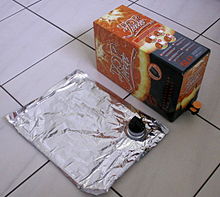Box wine
This article's tone or style may not reflect the encyclopedic tone used on Wikipedia. (December 2016) |

Boxed wine (cask wine) is wine packaged in a bag-in-box. Wine is contained in a plastic bladder typically with an air-tight valve emerging from a protective corrugated fiberboard box. It serves as an alternative to traditional wine bottling in glass with a cork or synthetic seal.
Alternative names[]
When removed from the outer box, the product may be referred to as a goon sack,[1] goon bag[2][3] or "Chateau Cardboard" in Australia.[4]
History[]
The process for packaging 'cask wine' (boxed wine) was invented by Thomas Angove, a winemaker from Renmark, South Australia, and patented by his company on April 20, 1965.[5] Polyethylene bladders of one gallon (4.5 litres) were placed in corrugated boxes for retail sale. The original design required that the consumer cut the corner off the bladder, pour out the serving of wine and then reseal it with a special peg[6] and was based on a product already on the market, which was a bag in a box used by mechanics to hold and transport battery acid.[7]
In 1967, Australian inventor Charles Malpas and Penfolds Wines patented a plastic, air-tight tap welded to a metallised bladder, making storage more convenient. All modern wine casks now use some sort of plastic tap, which is exposed by tearing away a perforated panel on the box. For the next decades bag in a box packaging was primarily preferred by producers of less expensive wines as it is cheaper to fabricate and distribute than glass bottles.
In Australia, due to the difference in how wine is taxed compared to other alcoholic beverages,[8][9][10] low quality boxed wine is often the cheapest available option by proportion of alcoholic content.[11] A 4 litre cask of at least 9.5% alcohol can often be found for around A$10.[12] These attributes have led to boxed wine being widely available throughout Australia and holding a prominent place in Australian pop culture.[13][14]

During the mid-1970s, the bag in box packaging concept expanded to other beverages including spring waters, orange juices, and wine coolers, however, today wine and spring water are the main two beverages packed into these bags.[citation needed]
In 2003, California Central Coast AVA based Black Box Wines introduced mass premium wines in a box.[citation needed] Within the decade, premium wineries and bottlers began packaging their own high-quality boxed wine.[citation needed] This coupled with an increased cultural interest in environmentally sustainable packaging has cultivated growing popularity with affluent wine consumers.[15]
Attributes[]
The Scandinavian state institutions Systembolaget und Vinmonopolet analysed the environmental impact of various wine packagings in 2010. Bag-in-Box packaging was found to leave only between 12 and 29% of the carbon footprint of bottled wine and also to be superior by every other ecological criterion.[16]
Bag-in-box packaging is less expensive and lighter than glass-bottled wine.
Tyler Colman from New York Times opined that it is more environmentally friendly than bottled wine [15] as well as being easier to transport and store. Typical bag-in-box containers hold one and a half to four 750 ml bottles of wine per box, though they come in a wide variety of volumes.[citation needed]
The fact that wine is removed from the flexible bag without adding air to fill the vacated space greatly reduces oxidation of the wine during dispensing. Compared to wine in a bottle which should be consumed within hours or days of opening, bag-in-box wine is not subject to cork taint and will not spoil for approximately 3–4 weeks after breaking the seal.[17]
Wine contained in plastic bladders are not intended for cellaring and should be consumed within the manufacturer printed shelf life. Deterioration may be noticeable by 12 months after filling.[18]
See also[]
- Goon of Fortune
- Wine cask
- Flavored fortified wine
- Jug wine, inexpensive table wine
References[]
- ^ Richards, Kel (2018-07-13). "Oz words: cask wine". Australian Geographic. Retrieved 2020-07-18.
- ^ McClintock, Alex (2 March 2015). "Happy Birthday Goon: Cask Wine Turns 50". The Guardian. Retrieved 2 March 2015.
- ^ "Wine cask". Powerhouse Museum. Retrieved 5 March 2007.
- ^ "chateau cardboard | Definition of chateau cardboard in English by Oxford Dictionaries". Oxford Dictionaries | English. Retrieved 2017-12-20.
- ^ Crystal Ja; AAP reporters (13 September 2009). "Eclectic mix honoured on Australia Day". The Sydney Morning Herald. Retrieved 12 March 2012.
- ^ "Wine cask". Powerhouse Museum. Retrieved 27 January 2008.
- ^ "Who Invented The Wine Cask (Goon Box)?". Good Goon Guide. 2017-08-06. Retrieved 2017-08-26.
- ^ Office, Australian Taxation. "Wine equalisation tax". www.ato.gov.au. Retrieved 2020-07-15.
- ^ Office, Australian Taxation. "Excise rates for alcohol". www.ato.gov.au. Retrieved 2020-07-15.
- ^ "The goon show: How the tax system works to subsidise cheap wine and alcohol consumption". The Australia Institute. Retrieved 2020-07-15.
- ^ "r/australia - What are the best options for Cheap Alcohol in australia?". reddit. Retrieved 2020-07-15.
- ^ "Sonata Estate Fresh Dry White Cask 4L". www.danmurphys.com.au. Retrieved 2020-07-15.
- ^ "We Asked Australia's Best Sommelier to Find the Nicest, Cheapest Goon". www.vice.com. Retrieved 2020-07-15.
- ^ Prestipino, David (2014-08-21). "Yeah, we went there: road testing five Australian cask red wines". The Sydney Morning Herald. Retrieved 2020-07-15.
- ^ Jump up to: a b Colman, Tyler, Drink Outside the Box; The New York Times (August 17, 2008).
- ^ Nordic LCA Wine Package Study – Final Report (PDF), Systembolaget and Vinmonopolet, August 2010, retrieved 2021-08-04
- ^ Lonvaud-Funel, A. (1999). Lactic acid bacteria in the quality improvement and depreciation of wine. Konings W.N., Kuipers O.P., In ’t Veld J.H.J.H. (eds) Lactic Acid Bacteria: Genetics, Metabolism and Applications. Springer, Dordrecht.
- ^ The Oxford Companion to Wine. "boxes, wine". winepros.com.au. Archived from the original on 2008-09-05.
- Australian inventions
- Food storage containers
- Wine packaging and storage
- Wine styles
- Wine terminology
